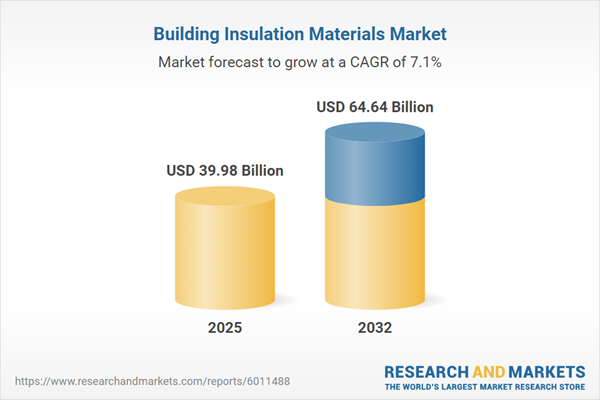Speak directly to the analyst to clarify any post sales queries you may have.
Decision-makers in commercial real estate and asset management are increasingly prioritizing advanced building insulation materials to strengthen risk mitigation strategies, ensure compliance, and support long-term asset resilience. Evolving regulations and operational needs position insulation as a core focus for portfolio efficiency and sustainability.
Market Snapshot: Building Insulation Materials Market Growth and Trends
The building insulation materials market is exhibiting sustained expansion, currently valued at USD 37.26 billion in 2024. It is expected to reach USD 39.98 billion in 2025 and is projected to climb to USD 64.64 billion by 2032, representing a compound annual growth rate (CAGR) of 7.12%.
This growth is driven by global decarbonization initiatives, implementation of stricter building codes, and increased operational energy costs. Leading industry stakeholders are responding by elevating their sustainability commitments and integrating operational technologies. Enhanced insulation strategies are recognized as fundamental to achieving modernization, compliance, and robust risk management across commercial property portfolios.Scope & Segmentation: Actionable Insights for Senior Leaders
This report provides senior decision-makers with a comprehensive segmentation framework designed to inform procurement, risk management, and operational improvements across the built environment. Coverage extends across installation strategies, end-use applications, material innovations, and regional adaptation, enabling targeted decision-making.
- Installation Modes: Highlights insulation solutions for new builds and retrofits, clarifying trade-offs in timelines, costs, and resilience across differing facility types and project stages.
- End Uses: Details specific insulation requirements for commercial, industrial, and residential sectors, guiding tailored compliance and risk management in line with asset characteristics.
- Applications: Examines insulation for ceilings, walls, roofs, floors, and foundations, focusing on how application choices influence energy performance and site-specific maintenance demands.
- Material Types: Compares materials like fiberglass, mineral wool, spray foam, expanded/extruded polystyrene, and polyisocyanurate, outlining their strengths, supplier differentiation, and relevance to procurement decisions.
- Forms: Reviews insulation delivery forms such as batts and rolls, rigid boards, loose-fill, and spray-applied products, highlighting impacts on installation efficiency and compliance needs.
- Regions: Assesses regional dynamics in North America, Latin America, Europe, Asia-Pacific, and Middle East & Africa, focusing on regulatory context, adaptation to climate, and evolving market drivers.
- Companies: Benchmarks strategies from top players, including Owens Corning, Compagnie de Saint-Gobain S.A., Kingspan Group plc, and ROCKWOOL International A/S, for leadership perspective and engagement models.
Key Takeaways: Strategic Insights for Building Insulation Materials
- Insulation selection drives energy strategies and is applicable to every phase of asset management, supporting operational longevity and facility adaptability.
- Growing use of recycled and bio-based materials is enhancing supply chain transparency and fostering responsible sourcing throughout the industry.
- Urban expansion and government incentives require insulation solutions that combine flexibility in design with responsiveness to changing climates and evolving codes.
- Procurement processes are focusing more on supplier dependability, product certification, and compliance with organizational governance standards.
- Digital innovation, including Building Information Modeling (BIM), is enhancing accuracy in planning, execution efficiency, and continuous monitoring of building performance.
Tariff Impact: U.S. Trade Measures Influence Industry Sourcing
Recent adjustments to U.S. tariffs are altering sourcing strategies for insulation materials. In response, there is increased prioritization of domestic manufacturing and automation, supporting both supply chain stability and timely access to specialized products. Market participants are also expanding technical service offerings to meet new compliance standards and evolving operational expectations.
Methodology & Data Sources
The findings are built on extensive interviews with insulation sector professionals and an in-depth assessment of technical and regulatory documents. The approach ensures actionable support for procurement and risk-based decision-making at the executive level.
Why This Report Matters
- Presents executive-ready frameworks and analytics, equipping leaders to refine procurement and risk strategies across multiple asset groups.
- Clarifies the impact of new technologies and supply chain shifts on long-range investment and operational planning.
- Enables benchmarking for sustainability, compliance, and governance objectives linked to insulation systems performance.
Conclusion
Senior decision-makers gain targeted insights to develop forward-looking insulation strategies and fortify portfolio resilience, positioning their organizations to navigate regulatory and operational changes with confidence.
Additional Product Information:
- Purchase of this report includes 1 year online access with quarterly updates.
- This report can be updated on request. Please contact our Customer Experience team using the Ask a Question widget on our website.
Table of Contents
3. Executive Summary
4. Market Overview
7. Cumulative Impact of Artificial Intelligence 2025
Companies Mentioned
The companies profiled in this Building Insulation Materials market report include:- Owens Corning
- Compagnie de Saint-Gobain S.A.
- Kingspan Group plc
- ROCKWOOL International A/S
- Johns Manville Corporation
- Knauf Insulation GmbH
- BASF SE
- Dow Inc.
- GAF Materials LLC
- Huntsman International LLC
Table Information
| Report Attribute | Details |
|---|---|
| No. of Pages | 187 |
| Published | October 2025 |
| Forecast Period | 2025 - 2032 |
| Estimated Market Value ( USD | $ 39.98 Billion |
| Forecasted Market Value ( USD | $ 64.64 Billion |
| Compound Annual Growth Rate | 7.1% |
| Regions Covered | Global |
| No. of Companies Mentioned | 11 |









